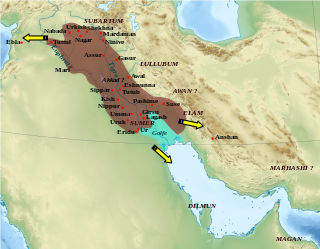
The Amarna letters are an archive, written on clay tablets, primarily consisting of diplomatic correspondence between the Egyptian administration and its representatives in Canaan and Amurru, or neighboring kingdom leaders, during the New Kingdom, spanning a period of no more than thirty years in the middle 14th century BC. The letters were found in Upper Egypt at el-Amarna, the modern name for the ancient Egyptian capital of Akhetaten, founded by pharaoh Akhenaten during the Eighteenth Dynasty of Egypt.

The land of Subartu or Subar is mentioned in Bronze Age literature. The name also appears as Subari in the Amarna letters, and, in the form Šbr, in Ugarit.

Abdi-Ḫeba was a local chieftain of Jerusalem during the Amarna period. Egyptian documents have him deny he was a mayor (ḫazānu) and assert he is a soldier (we'w), the implication being he was the son of a local chief sent to Egypt to receive military training there.
Ushu was an ancient mainland city that supplied the city of Tyre with water, supplies and burial grounds. Its name was based upon the mythical figure Usoos or Ousoüs, a descendant of Genos and Genea whose children allegedly discovered fire, as recorded by Sanchuniathon (Sankunyaton).

Barga was an ancient city and later kingdom in the Syrian Coastal Mountain Range in the Bronze age and Iron age.
Upu or Apu, also rendered as Aba/Apa/Apina/Ubi/Upi, was the region surrounding Damascus of the 1350 BC Amarna letters. Damascus was named Dimašqu / Dimasqu / etc. (for example, "Dimaški"-, in the letter correspondence.

Ayyab was a ruler of Aštartu south of Damascus. According to the Amarna letters, cities/city-states and their kings in the region — just like countries to the north, such as Hatti of the Hittites, fell prey to a wave of attacks by ʿApiru raiders. The Amarna correspondence corpus covers a period from 1350–1335 BC.
Šatiya, also Satiya, or Shatiya was the ruler-'mayor' of Enišasi, during the Amarna letters period of 1350–1335 BC. In the entire correspondence of 382–letters, his name is only referenced in his own letter to the Ancient Egyptian pharaoh, EA 187,. Šatiya's city/city-state of Enišasi is only referenced in one other letter, authored by another mayor of Enišasi, Abdi-Riša.
Enišasi, was a city, or city-state located in the Beqaa Valley-(called Amqu, or Amka) of Lebanon, during the 1350-1335 BC Amarna letters correspondence. Of the 382–Amarna letters, Enišasi is only referenced in two letters. Enišasi was located near Hašabu,, and Hasi,, southwest of Baalbek.
Biridašwa was a mayor of Aštartu, (Tell-Ashtara), south of Damascus,, during the time of the Amarna letters correspondence, about 1350–1335 BC. A second mayor of Aštartu, Ayyab, existed in this short 15–20 year time period.
Arsawuya was a 'mayor' of Ruhizzi, located east of Qidšu-(Kadesh), and farther east beyond the Anti-Lebanon mountain range, during the 1350–1335 BC Amarna letters correspondence. He is referenced in five letters, two letters of which he wrote to the Egyptian pharaoh, letters EA 191, and 192,.
Milki-ilu of Gezer, was the mayor/ruler of the Land of Gazru (Gezer) around 1350 BC. He is known as the son-in-law of Tagi of Ginti-Kirmil and cooperating with Labaya of Shechem, during a period of turmoil among the vassals of Egypt. He is accused of being a rebel, employing mercenaries from the Habiru men.

Tunip was a city-state along the Orontes River in western Syria in the Late Bronze Age. It was large enough to be an urban center, but too small to be a dominant regional power. It was under the influence of various factions like the Mitanni, Egyptians, and Hittites.
Yursa was a town from the 1350–1335 BC Amarna letters correspondence. The site, a city/city-state, is probably in the southern Canaan close to Gaza. Some scholars identify it with Tell Jemmeh.
The Amqu is a region during the Late Bronze Age, equivalent to the Beqaa Valley region in eastern Lebanon, named in the 1350–1335 BC Amarna letters corpus.
Rubutu was a city, or city-state located in ancient northern Israel, between the city of Gazru-(modern Gezer), and Jerusalem during the time of the Amarna letters correspondence, a 15-20 year period at about 1350-1335 BC. Some scholars place Rubutu near present-day Arrabah in the northern West Bank.
Nuribta, also Nuribda, was a city, or city-state, located in the vicinity of Magiddo in Israel, in historical Canaan during the time of the Amarna letter correspondence, a 15 to 20 year period from about 1350 to 1335 BC.

The Salhi is a region/city-state in the vicinity of Ugarit during the 15-20 year Amarna letters correspondence of 1350–1335 BC.

Tel Hanaton is an archaeological tell situated at the western edge of the Beit Netofa Valley, in the western Lower Galilee region of Israel, 2 km south of the Town of Kfar Manda and 1 km northeast of the kibbutz which took its name, Hanaton.

Amarna letter EA 365, titled Furnishing Corvée Workers, is a squarish, mostly flat clay tablet, but thick enough (pillow-shaped), to contain text that continues toward the right margin, the right side of the obverse side, and also to the right side of the reverse side of the tablet.









